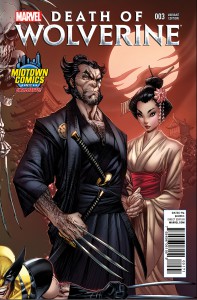
Written by Charles Soule
Pencilled by Steve McNiven
Inked by Jay Leisen
Colors by Justin Ponsor
Published by Marvel Comics
Even if Charles Soule’s script reads like a compilation of the best solo Wolverine stories all rolled into one miniseries, Death of Wolverine #3 is another shining example of why Steve McNiven is one of the best Wolverine artists. He, inker Jay Leisen, and colorist Justin Ponsor show the serenity and violence of Wolverine’s relationship with Japan. Soule even gives him some bits of samurai poetry to say to Kitty Pryde and an old enemy to show how he is coming to grips with his death as well as wisdom he has picked up on his many travels. When McNiven uses the whole page (or two) as a canvas, he creates some of the most iconic, poster-worthy Wolverine art. If you think the cover with the katana blade splitting through his face is the tip of the iceberg, there is more like it in the comic. Soule’s writing isn’t bad, and he takes enough time to reflect on Wolverine’s life and past between the action beats. However, the plot continues to be Wolverine traveling to old haunt, tussling with old foe, and being driven another old haunt and foe. This creates a tight, linear narrative, but Wolverine could have had a few more moments with Kitty and the villain where they’re not exposition delivery devices.
Steve McNiven gives each page layout a unique feel to make it work better with specific story beats. For quick knife or martial arts fighting scenes, he uses small panels to show the fighter’s skill or grace with a thinner line from inker Jay Leisen to show its speed. The fights in Death of Wolverine #3 are a little on the short side, but are well-choreographed and use the combatants’ specific skill set. Phasing has never been so grotesque. McNiven also shows the strain fighting takes on Wolverine as it takes him a few more panels to recover from each takedown, and the lines across his face are deeper. This corresponds to Soule’s writing as Wolverine sees Japan (probably remembering the good days here and his marriage to Mariko Yashida) and thinks about getting away, growing old, and dying peacefully instead of continuing to fight legions of ninjas, assassins, super soldiers, and whatnot. Justin Ponsor utilizes a soft, basically pastel color palette for these reflective scenes before going back to a colder one with plenty of reds, blacks, and dark blues for the fights. McNiven and the art team see the warrior poetry in Wolverine and makes sure he has one last chance to play samurai before he rides off into the sunset.
The beautiful art makes the average plot a lot more palatable. There are lots of full page and double page spreads in Death of Wolverine #3, and Soule doesn’t clutter them with too much text. However, he ends up turning this issue’s third act into a table setter for the final one taking away from it being a story in of itself. But Soule does a lot of things right starting with Death of Wolverine #3’s interesting and subversive relationship with the Kitty Pryde and Wolverine miniseries. His Wolverine is the perfect mix of warrior and poet. Some writers forget how well-read and spoken Wolverine actually is even if he does get into a lot of bar fights etc. Soule’s Wolverine is facing his own death and adjusts his eloquence accordingly. Letterer Chris Elioupolos’ caption boxes provide the right amount of “beast” for him as they give readers a glimpse into how Wolverine perceives the world showing his most sublime and savage moments from flowers to blood and viscera. Hopefully, Soule bottles up some of this beauty and uses it a lot more in the finale to go with what could go down as one of the most visually pleasing Wolverine stories of all time.

